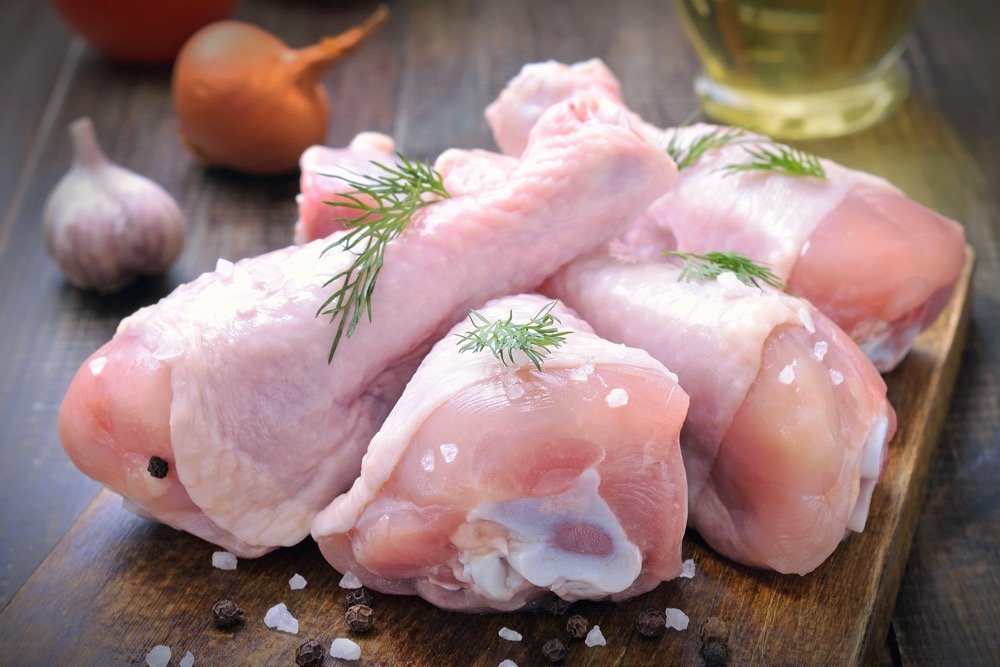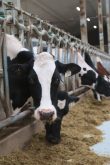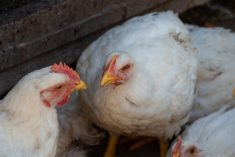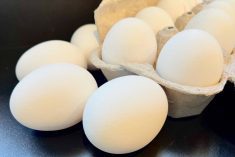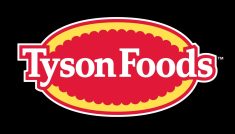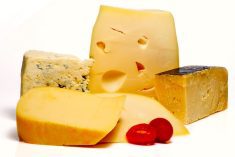Long-awaited programs to make up for market share lost to imports under the Trans-Pacific Partnership trade pact are set to roll out to Canada’s chicken, egg and turkey farmers.
Agriculture Minister Marie-Claude Bibeau and caucus colleagues on Tuesday announced the specific contents of her previously-pledged $691 million, 10-year compensation funding envelope: a Poultry and Egg On-Farm Investment Program and a Market Development Program for Turkey and Chicken.
“These two programs deliver on the promise our government made for full and fair compensation and are designed in direct response to industry demands,” Winnipeg MP Jim Carr, the federal cabinet’s special representative for the Prairies, said in a release.
Read Also

Trump tariff on Brazilian goods could jack up U.S. burger price
U.S. President Donald Trump’s plan for a 50 per cent tariff on goods from Brazil will likely raise prices for the beef that is used in American hamburgers, traders and analysts said on Thursday, as food manufacturers increasingly rely on imports during a time of declining domestic production.
“These compensation packages were an important part of the historic trade deal we struck with our Pacific trading partners, that has already been hugely beneficial to our export-reliant agricultural industries.”
On-farm investment
Under the Poultry and Egg On-Farm Investment Program, for which the intake of applications is to launch “later this spring,” chicken, turkey, egg and broiler hatching egg producers will share almost $630 million over 10 years.
Eligible producers will be entitled to an amount of on-farm investment based on their quota holdings as of Jan. 1, 2021, the government said in a release.
Projects eligible for cost-shared funding will be “anything that helps a producer modernize, become more competitive and adapt to changing consumer preferences,” for which the program will provide up to 70 per cent of the cost. For young producers — that is, age 35 or younger as of Jan. 1, 2021 — that ratio will run up to 85 per cent.
Producers can apply for funding under the program “whenever they are ready to invest,” the government said, and if applications exceed the program’s allocation for a given year, they may be approved to be reimbursed in a future fiscal year, so as to avoid delaying the start of the project.
The program will also consider eligible costs retroactive to the announcement of support for supply-managed sectors made on March 19, 2019 in that year’s federal budget.
However, the government cautioned that for such “retroactive activities,” the applicant assumes the risk of not being reimbursed if the project doesn’t get approved or the costs are deemed ineligible under the program.
Among the examples of eligible projects are new barn construction or upgrading equipment such as feeding, watering, lighting, ventilation, heating and comfort systems that will “promote energy efficiency and reduce environmental footprint.”
On-farm investment funding will be distributed starting in 2021-22, the government said, with $347.3 million allocated for chicken producers, $59.6 million for turkey producers, $134 million for egg producers and $88.6 million for broiler hatching egg producers over the 10-year period.
Among the examples of the sort of funding a producer could expect, the government said an “average” chicken farmer, who produces 448,202 kg per year, would have access to up to $122,411.
A turkey farmer producing 302,299 kg per year, could qualify for up to $114,195; an egg farmer producing 654,772 dozen eggs per year, $111,203; and a hatching egg producer who produces 3,413,983 eggs per year, $375,297.
Table: Poultry and Egg On-Farm Investment Program’s expected allocation by region (in millions of dollars). Source: AAFC.
| Region. . | Chicken. . | Turkey. . | Egg. . | Hatching egg |
| B.C. | 48.1 | 7.9 | 16.9 | 13.9 |
| Prairies | 60.7 | 11.5 | 32.5 | 17.4 |
| Ontario | 119.4 | 23.8 | 47.7 | 29.1 |
| Quebec | 92.0 | 13.5 | 27.2 | 23.3 |
| Atlantic | 27.1 | 2.9 | 9.7 | 4.9 |
| National | 347.3 | 59.6 | 134.0 | 88.7 |
Market development
The government said Tuesday it would open the intake for applications to the Market Development Program for Turkey and Chicken that day. That program allocates $36.5 million for Turkey Farmers of Canada and $25 million for Chicken Farmers of Canada over 10 years.
The program is to help fund “promotional activities that differentiate Canadian-made products’ reputation for high-quality, safe and sustainably farmed food that adheres to strict animal welfare standards.”
Among examples of eligible activities given were:
- sector-wide advertising and promotion;
- promotional activities that “build public trust” in Canadian turkey and chicken products;
- market research;
- developing and/or expanding target audiences;
- increasing delivery of current market development activities;
- encouraging product development, product testing and research into new innovative processing and packaging technology at the primary and further-processing levels; and
- adapting current branding to meet “changing consumer expectations.”
Under the program, Agriculture and Agri-Food Canada would provide 80 per cent funding for eligible projects, cost-shared with industry. AAFC also said it could provide up to 90 per cent funding for “specific projects aimed at promoting inclusiveness and diversity in the market development activities supported by the program.”
To access the funding, the two national industry organizations will submit a “multi-year strategy” to Agriculture and Agri-Food Canada for approval.
‘Long-term losses’
The four national feather sector organizations hailed Tuesday’s announcements, saying the funding will help Canadian farmers boost their competitiveness against imports from the Trans-Pacific Partnership (CPTPP) member nations.
“The combination of these programs will allow farmers to plan for the future, navigate the unique dynamics of our respective industries, and contribute to Canada’s goals of growing our agricultural sector,” the groups said in a separate release Tuesday.
The on-farm investment program, they said, “will in turn generate economic activity and investments in rural and urban communities across Canada at a time where our small businesses are hurting, and our local economies need it the most.”
The market development program, they added, will allow the chicken and turkey sectors to “enhance consumer engagement and continue to promote Canadian-made products to Canadians.”
“Today’s announcement offers new opportunities for our farmers to reinvest in their operations and plan for the future as they navigate the long-term market losses under the CPTPP agreement,” Egg Farmers of Canada chair Roger Pelissero said Tuesday in the government’s release.
The government said it also “remains committed to engaging the sector on full and fair compensation” for market share ceded separately under the Canada-U.S.-Mexico Agreement (CUSMA), the successor pact to NAFTA.
Further, the government said Tuesday it also “remains committed to addressing the impacts of recent trade agreements on processors,” as farmers and processors “depend on each other to be successful.”
Dairy payouts
Separately, the government announced last week it had seen 9,682 dairy farmers register for the second year of the Dairy Direct Payment Program, that sector’s compensation program for market share ceded in the CPTPP and Canada-European Union (CETA) trade pacts.
Payments to that group would total $459.4 million, the government said, bringing the total payout so far up to $813 million from the program’s $1.75 billion envelope.
The government said in November it would shorten the dairy program’s payment schedule to four years, down from the eight-year timeline announced in 2019, and instead complete all payments by 2023. — Glacier FarmMedia Network





